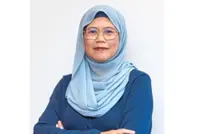Panel looking at the opportunities and challenges for the Asean Power Grid: moderator, UNSDSN Asia's Prof Leong Yuen Yoong, Bunyak, Shani, Wittenstein and Dr Feng Limin. — Quicktime Photo Studio/UNSDSN Asia
IMAGINE this: A clean and green power grid connecting not only all 10 member states of Asean but also linking China, Japan, Korea, Australia and New Zealand.
Renowned economist and sustainable development exponent Prof Jeffrey Sachs believes this can be achieved within the next 20 years, if the essential conditions are met. In fact, as Prof Sachs tells the recent High-Level Convening on Asean’s Integrated Energy and Digital Future, held at Sunway University, it is urgently necessary.
“We’ve already reached 1.5°C, we will reach 2°C within 20 years, and we are at risk of extremely dire tipping points in many parts of the world, including destruction of the ice sheets and multi-metre sea level rise; destruction of the rainforests, and many other shocking events that are becoming likely—because we have not cracked a problem that was recognised 33 years ago when the United Nations Framework Convention on Climate Change was signed, and has not been solved in the 30 years of diplomacy over that treaty,” says the UN Sustainable Development Solutions Network (UNSDSN) president and distinguished honorary professor at Sunway University Tan Sri Sir Jeffrey Cheah.
Noting that this energy system transformation is complicated and expensive, Prof Sachs stresses that what is needed is a bold plan of action, which is then implemented courageously and effectively.
“It is a complicated problem as the energy system is at the core of our economy.
“Making a deep transformation of the core of the economy is not a simple matter, both because it is technologically complex, politically charged and there are powerful vested interests.
“Crucially, it’s a long-term problem that is regional, not national. That means that any sensible approach of energy system transformation requires a high level of regional cooperation,” he says at the high-level convening organised by the UNSDSN Asia on May 25.
While China—as the fastest implementer in the world of this transformation—is key, Asean is also central with its Asean Power Grid (APG) plan, Prof Sachs adds.
Malaysia as the current chair of the regional bloc has a vital role to play to accelerate the APG to ensure Asean’s sustainable future and economic growth.
Integrated mission
The Asean Power Grid is a regional initiative aiming to link up the energy infrastructure of Asean.
“The Asean leaders’ vision is for the region to be fully interconnected by having cross-border interconnection between member countries by 2045,” explains Power Generation and Interconnection Department, Asean Centre for Energy (ACE) manager Nadhilah Shani.
Prof Sachs recommends that the Asean member states draw up a comprehensive plan for a regional power sector that has a low-carbon, high-efficiency energy system.
“That would mean that electricity is transmitted readily across borders in an Asean-wide marketplace. It will create an economy for all of the downstream infrastructure for electric vehicles, clean shipping, public transport and so forth.
“It will also form a hydrogen economy that would be important for metallurgy, steelmaking, shipping, and also create advanced biofuels for aviation fuel, and so forth. A systems approach that incorporates all ten countries in an integrated manner, and that links Asean with China, with Australia, New Zealand, Japan, Korea, in a regional comprehensive economic partnership,” he says.
Shani points out that Asean has made notable progress in developing APG infrastructure and markets.
“Moving forward, Asean must accelerate feasibility assessments across the remaining projects to advance them to a bankable, investment-ready stage. The region needs to explore more streamlined, multilateral market mechanisms to enable dynamic, real-time trading.
“This could better accommodate variable renewable supply, like hydropower, and fluctuating demand, ultimately unlocking greater efficiency and resilience in Asean’s power trade,” she notes. In Malaysia, one of the leading renewable energy suppliers is Sarawak, which is developing the Borneo Grid that will then be part of the APG.
“We want to be the battery of Asean. Our vision is to drive sustainability for Sarawak through developing our renewable energy industry and reliable renewable power to the region. We are guided by Sarawak post-Covid development strategy to be a developed state by 2030. One of the key levers to do that is to develop our renewable energy,” says Sarawak Energy Bhd subsidiary SEB Power’s chief executive officer Bunyak Lunyong.
Shani, who represents ACE executive director Datuk Abdul Razib Dawood at the convening, adds that rising demand for clean energy, especially from large industries, will spur renewable investments, driving regional economic growth.
“Malaysia’s Asean chairmanship offers a key opportunity to fast-track APG development and unlock these strategic benefits. Accelerating the APG is crucial for ensuring Asean’s sustainable energy future and economic growth,” she says.
Progress is being made to achieve this: on May 26, the Renewable and Interconnected Sustainable Energy agreement, involving land-based and undersea transmission infrastructure, was signed at the 46th Asean Summit in Kuala Lumpur. Still, experts at the event agree that more needs to be done for the region to accelerate its sustainable future.
Finance and knowledge
According to the United Nations Economic and Social Commission for Asia and the Pacific (UNESCAP) energy connectivity section chief Matthew Wittenstein, Asean needs a formalised mechanism to really enable a fully multilateral, multidirectional power trade.
“You need the grid infrastructure to be built more rapidly, which means you need the financing to be available. You also need the planning to be more harmonised and integrated. And you need a recognition that all countries must sit at the table equally so they can reap the benefits that they need and that they deserve in a way that’s reflective of their contribution to the process,” Wittenstein tells the high-level convening. He says he believes these are achievable in Asean, but there’s a lot of work still to be done.
“One example is the need for a stronger institutional framework, where regulators can participate in. So we have the concept now of an Asean School of Regulation which will be hosted by Sunway University for a start. We’re doing this in partnership with the Asean secretariat and ACE.
“The idea is to create a formalised institution where all the regulators come together, learn what they need to learn to both achieve the Asean power grid and meet domestic needs. What else do they have to do to serve their own communities better?
“We’re testing this out this summer with the summer school, which will also train and nurture the next generation of energy policy leaders. I think it’s really exciting. It’s modelled, for those of you who know the European context, from the Florence School of Regulation. This is not a new idea, but new to this region.”
The UNSDSN Asia will also be the academic partner for ACE during the upcoming fifth Asean Energy Conference this October.







